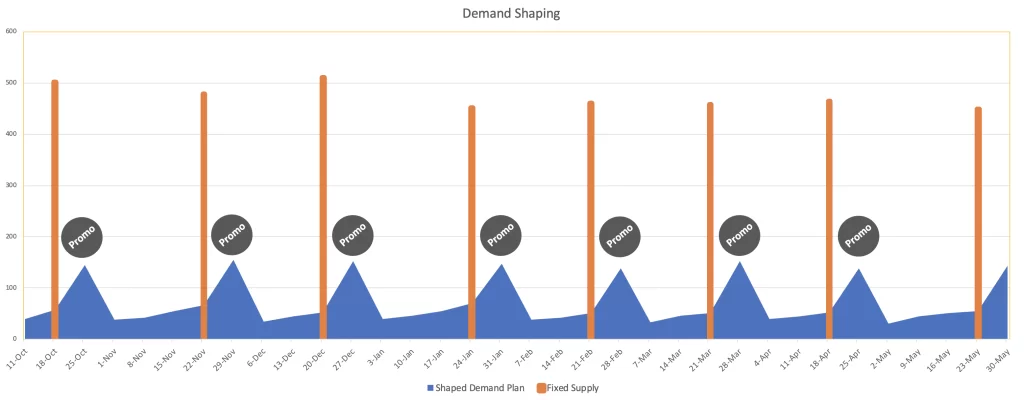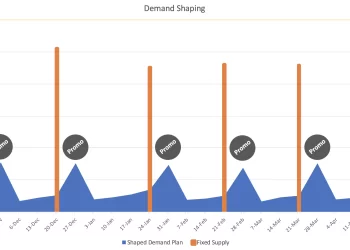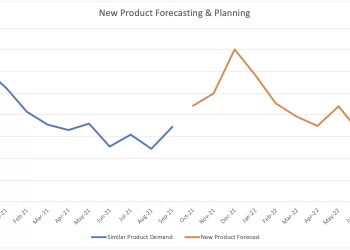Best Practices for Demand Sensing, Demand Shaping, & Influencing Demand

Despite vast improvements in the tools and techniques available today for demand sensing and demand shaping, a lack of forecast accuracy still prevents many businesses from optimally managing production, distribution, inventories, and sales to meet shifts in demand. This is often because:
- True demand is clouded by stock-outs or purchases of substitutes.
- There is a lack of accurate historical data.
- It can be difficult to forecast demand for the custom, configurable products that today’s customers expect.
- Forecasts that are based on high-level, aggregated demand are not as accurate as forecasts based on disaggregated data at the POS, SKU, or store level.
- Time lags between when changes in demand are identified and the relevant upstream changes are made.
Demand sensing offers us an effective way forward to overcome these issues.
Understanding Demand Sensing
Demand sensing is part art, part science. It is the process of identifying short-term trends so that you can better predict what, when, and where your customers will want your product or service. Many traditional forecasting techniques work on quarter-long or month-long forecasts. Instead of using such a static forecast, demand sensing allows you to challenge older forecasts with more accurate sales data from the field – data that can help you make the right production, pricing, distribution, and marketing tweaks that can help you boost your profits.
Once you can sense demand, you can shape demand. Demand shaping is the use of, for example, discounts, price incentives, product substitutions, and other offers to entice users to purchase a specific item.
A series of accurate short-term forecasts (via demand sensing) will lead to longer-term profitability (via better demand shaping). When done right, an effective demand sensing system will help you rapidly analyze demand data and make adjustments as needed in near real-time.
Demand sensing requires you to:
- Leverage granular demand data as close to the end-user as possible to quickly and accurately detect changes in demand.
- Build visibility into your supply chain so that you can identify demand changes at points of sale and changes that result from promotions, social activity, media coverage, as well as macro factors such as weather, seasonality, interest rates, and other global developments (such as the COVID-19 pandemic). This visibility should allow you to make short-term improvements to your current forecast and optimize your inventory placement.
Combined, these capabilities can help you reduce uncertainty and make important adjustments to your forecast without having to wait for the next forecasting cycle.
Using Demand Sensing to Turn Insights into Action
Here are a few ways demand sensing can help businesses in a variety of situations turn insight into action.
- Reduce data latency if there is a distributor or retailer between you and the customer. With effective demand sensing, you can collect POS data and use it to improve service and make supply-side adjustments without having to wait for the distributor or retailer.
- Relocate inventory in the short-term from where it is available but not wanted to where it is unavailable and wanted.
- Improve seasonal forecasts, especially for fast-moving and perishable items. If an item does not sell as expected or a POS runs out of stock, you can adjust production, distribution, or inventory to avoid stock issues at those locations.
- Optimize inventory and placement for new products that replace or are sold alongside older products.
- Better understand how promotions and marketing campaigns affect demand. Sell-in data can help you calculate promotional uplift and improve forecasts for future campaigns.
Getting Started with Demand Sensing
If you are sold on the ability of demand sensing to help you extract new insights, improve your response times, and improve profitability, here is how you can maximize the returns on investments you make toward improved demand sensing capabilities.
- Perform short-term forecasts using sell-in data.
Use granular data such as daily sales and shipping data to improve and adjust forecasts daily.
- Leverage sell-out data.
You can identify potential flags and better predict downstream trends using data such as POS and channel data. This will also help you reduce the time lags that exist between different points along your supply chain.
- Incorporate external data and identify cause-effect relationships.
To further improve demand sensing, integrate relevant variables into your forecasts, such as market fluctuations, competitor products and promotions, viral social trends, weather, and other macroeconomic factors.
Using sell-in and sell-out data with relevant cause-effect variables will give you the most complete and comprehensive picture of market demand possible. This data can then be used for performing automated, machine-driven demand sensing that can lower costs and iteratively improve accuracy.
Using Demand Sensing to Improve Forecast Accuracy
There are many ways you can improve the three-step demand sensing process outlined above. Here are a few recommendations.
- Compare POS data against your short-term forecast to identify movements beyond expected ranges to adjust your forecast.
- Use order history data to sense demand for B2B customers. Stockpiles of inventory with manufacturers along the supply chain can make your POS data unreliable. Use data on sales, closed orders, and open orders from manufacturers for more insight into demand along your supply chain rather than simply relying on demand figures from POSs.
- Track the competition. You may not be ready to respond to a competitor’s promo campaign when it is first launched, but once you understand how such promos affect your sales, you can proactively initiate damage control once a competitor launches a new campaign by immediately adjusting production, distribution, inventories, and your sales forecast accordingly.
- Reposition inventory if a competitor faces issues due to, for example, raw material shortages, quality issues, or manufacturing breakdowns.
Contact Us Today
At Causometrix, we help businesses accurately forecast demand for new products and services. Using proprietary and battle-tested AI and machine learning algorithms, we analyze vast amounts of data and custom-build models based on the factors and inputs that matter to your line of work. Our predictive analytics can help you generate forecasts down to the SKU and store level – even if you have no prior sales history. Our platform also accounts for factors such as seasonality, resource fluctuations, store times, promotions, price elasticity, related/competing products, and more so that you can generate the most accurate demand and supply chain forecasts possible.
With the Causometrix platform, you can enjoy a unified and data-driven approach to sales and demand forecasting that will help you manage everything from pricing and inventory to marketing and customer support. Contact us today at https://www.causometrix.com/contact-us to reach one of our Supply Chain Planning Solutions Specialists.
Topics:
Recent Posts
-
Best Practices for Demand Sensing, Demand Shaping, & Influencing Demand
Despite vast improvements in the tools and techniques available today for demand sensing and demand shaping, a lack of forecast accuracy still prevents many businesses from optimally managing production, distribution, inventories, and sales to meet shifts in demand. This is often because:
October 12, 2021 Read more -
How to Effectively (and Accurately) Forecast and Plan for New Product Demand
Many businesses, large and small, have a huge source of great ideas that can help them improve, innovate, and grow, and yet so many of these companies never think of using this amazing corporate asset. What is this highly valuable asset? Its own people.
September 28, 2021 Read more -
How to Measure your Demand Forecasting Accuracy
Many businesses, large and small, have a huge source of great ideas that can help them improve, innovate, and grow, and yet so many of these companies never think of using this amazing corporate asset. What is this highly valuable asset? Its own people.
July 13, 2021 Read more
Subscribe to email updates from Causometrix!
Stay up-to-date with Causometrix


